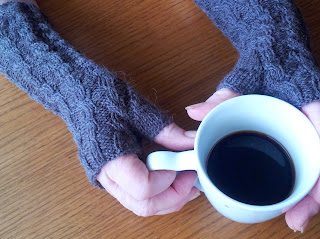
This work by Knitting and so on is licensed under a Creative Commons Attribution-NonCommercial-ShareAlike 3.0 Unported License
Materials:
Fingering weight yarn (ca. 35 gr)
3mm dpns
stitch holder or waste yarn
The finished mitts will measure 20cm in lenght and ca. 16 cm in circumference
Instructions:
CO56
join in round (14 sts on each needle)
knit 8 ribbing rows:
*p1 k6 p3 k2 p2* (repeat)
start pattern
row 1: *p1 k6 p3 k2 p2* (repeat)
row 2 = row 1
row 3: *p1 C6F p3 C2F* (repeat)
row 4 = row 1
row 5 = row 1
row 6: *p2 k4 p3 k4 p1* (repeat)
row 7 = row 6
row 8: *p2 C4F p3 C4F p1* (repeat)
row9 = row 6
row 10 = row 6
row 11: *p3 k2 p3 k6* (repeat)
row 12 = row 11
row 13: p3 C2F p3 C6F* (repeat)
row 14 = row 11
row 15 = row 11
row 16: *p2 k4 p3 k4 p1* (repeat)
row 17 = row 16
row 18: *p2 C4F p3 C4F p1* (repeat)
row 19 = row 16
row 20 = row 17
start again from row 1
start thumb gusset at stitch 8 in row 20 of the 2nd pattern repeat
after row 13 in 3rd repetition: do 7 rows of ribbing, i.e. *p1 k2 p3 k6 p2* (repeat)
bind off in 8th ribbing row

Thumb gusset
start increases around stitch 8 in row 20 of the 2nd pattern repeat and increase by two sts in every other row, i.e.
in row 19 of 2nd repetition: p2 k4 p1 pm p1 pm p1 k4 p (→ set-up)
in row 20 of 2nd repetition: p2 k4 p1 marker m1right k1 m1left marker p1 k4 p1 (→ increases)
in row 1 of 3rd repetition: p1 k6 marker k3 marker p2 k2 p2 (→ no increases)
in row 2 of 3rd repetition: p1 k6 marker m1right k3 m1left marker p2 k2 p2 (→ increases)
in row 3 of 3rd repetition: p1 C6F marker k5 marker p2 C2F (→ no increases)
… until there are 17 sts between the markers
place sts on markers on stitch holder and CO1 (backloop cast-on) above, so that there are again 56 sts on your needles
Thumb
move stitches from stitch holder on two dpns
pick up 7 sts from above thumb gusset (→ 24 sts)
round 1: k
round 2: k2tog k20 ssk (→ 22 sts)
round 3: k
round 4: k2tog k18 ssk (→ 20 sts)
round 5: k
round 6: bind off


Nice pattern - in english
AntwortenLöschenWhat is C47 C6F I realise that they are cables but what kind of cable
AntwortenLöschenwhat does C4F and C6F mean I realise that they are cables but what kind
AntwortenLöschenYes, they are cables. A good explanation was given in Stephanie MILLER LACY's answer.
LöschenC4F = Slip next 2 sts onto a cable needle. hold cable needle at front of work, knit 2 sts from left-hand needle, then knit 2 sts from cable needle (the "cable" is 4 sts wide)
C6F = Slip next 3 sts onto a cable needle. hold cable needle at front of work, knit 3 sts from left-hand needle, then knit 3 sts from cable needle
You can find out more about cables here: http://www.mahalo.com/how-to-knit-a-cable-stitch/
"C6F" is (in row 2 of this pattern):
AntwortenLöschenrow 1: *p1 k6 p3 k2 p2* (repeat)
row 2 = row 1
row 3: *p1 C6F p3 C2F* (repeat)
(Notice, this is knitting "in the round", so you NEVER "turn at end of odd rows and work all even rows in "purl" sts.)
Here "C6F" in row 3 is the "cable twist" worked over the "k6" sts of row 1.
"C6F" here means you're working with a 6-stitch-wide cable: slip 1st 3 (of 6 knit sts) onto a C (Cable needle) & hold in F (Front); Knit Next 3 sts; then Knit the 3 sts from the C needle.
"C4F" is the same, except you're working a 4-st-wide cable, & slipping first 2 sts onto a C needle & holding in Front, knitting next 2 sts, then knitting the 2 sts from the C needle.
These techniques are usually both described & shown in pictures in good knitting books, also.